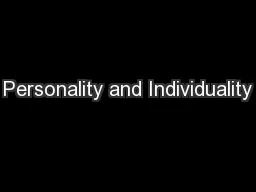

Theories of Personality Psychological Testing What do you know What do we mean by Personality Consistent enduring unique characteristics What constitutes Individuality Differences in the way people think feel and act ID: 312529
Download Presentation The PPT/PDF document "Personality and Individuality" is the property of its rightful owner. Permission is granted to download and print the materials on this web site for personal, non-commercial use only, and to display it on your personal computer provided you do not modify the materials and that you retain all copyright notices contained in the materials. By downloading content from our website, you accept the terms of this agreement.
Slide1
Personality and Individuality
Theories of Personality
Psychological TestingSlide2
What do you know?
What do we mean by Personality?
Consistent, enduring, unique characteristics
What constitutes Individuality?Differences in the way people think, feel and act
Personare
= to speak throughSlide3
Why do we create theories?
Looking for patterns in the way people behave
Explain differences, considering:
Motives (i.e. want recognition)How motives were established (i.e. winning has led to recognition)Underlying issues (i.e. childhood conflict - demanding parent)Slide4
What questions do personality theorists ask?
Why do problems arise?
Why are problems more difficult for some people than others?
How can lives be improved?Slide5
Major Personality Theories
Psychoanalytic
Unconscious motives: Freud, Jung, Adler
LearningBehaviorist (Rewards and punishment): Skinner Social learning (Observation): BanduraHumanistic / CognitivePersonal growth: Maslow
Thoughts, perceptions & feelings: Rogers, KellyTraitCharacteristics: Allport,
Cattell, Eysenck
Graphic Organizer 14 “Theories of Personality”Slide6
Quiz 14-1Slide7
What’s Your Sign and Does it Matter?
Is there a correlation between birth month and personality?
Work in groups of 4
Create a hypothesisConduct the experiment and record dataAnalyze the results and assess the experimentShare your findingsSlide8
Psychoanalytical Theories
Unconscious mind stores memories that influence behavior
Basic personality formed in childhood
Mind has three levels:Id (instinctual and biological urges)Ego (in touch with reality, mediates)Superego (moral principles
)
Ego protects itself using defense mechanismsSlide9
Defense Mechanisms
Rationalization (make excuses)
Repression (deemphasize problem)
Denial (don’t accept situation)Projection (attribute own view to others)Reaction formation (compensate)Regression (act immaturely)Displacement (take frustration out on low risk target)
Sublimation (work off frustration productively)
FreudSlide10
Defense Mechanisms
Good or bad?
Relieve stress, help weather crisis, time to work out problems
Distort reality, avoid problemsSlide11
Freud’s context
Victorian era (19
th
century)Morality, PDA’s and sex talk prohibitedLed to repressed feelings & sexual desiresPushed into unconsciousEmerge as cutting remarks, sarcasm, dreams, slips of the tongue
Freudian slips (dimples, alto sax, simulator)Psychoanalyst “shrinks” patient back to childhood to unlock repressionSlide12
Jung
Collective unconscious: storehouse of instincts, urges, and memories of entire human species throughout history
Archetypes: inherited, universal ideasSlide13
Adler
Driving force = desire to overcome feeling inferior
Inferiority complex = avoiding feelings of inadequacy rather than working on source problemSlide14
Quiz 14-2Slide15
What would Freud do?
Analyze the 8 situations described in your booklet
Select a defense mechanism he might employ in each situation
Describe how it might unfoldShare your responsesSlide16
Learning Theories
Personality is learned
Different experiences…different personalitySlide17
Behaviorism
Behavior can be predicted and controlled
Contingencies of reinforcement (rewards & punishments)
SkinnerSlide18Slide19
Social Cognitive
We observe and imitate models of choice
Reciprocal determinism (individual + behavior + environment)
Individual: beliefs, expectations (self-efficacy), emotions, genetics, social roles…
BanduraSlide20
Quiz 14-3Slide21
Humanistic Theories
Studied successful people…not seeking treatment
Human nature basically good
Personal growth toward potential (self-actualization)
MaslowSlide22
Cognitive Theories
Need
positive regard (approval)
Self = our image of who we are & what we valueSelf and person in synch…fully functioningConflicts from conditions of worth (judgements)
Unconditional positive regard
RogersSlide23
Cognitive Theories
Based on analysis of our own perceptions, thoughts and feelings
Personal construct theory = how we behave based on predictions about the world
Schemas = mental representations of people, events and concepts
KellySlide24
Quiz 14-4Slide25
Self-Actualization
Application Activity 14Slide26
Trait Theories
Trait = behaviors that characterize individuals
Every trait applies to all people (i.e. dependence or aggression)
Descriptions can be quantified (i.e. on a scale of 1 to 10)Slide27
Allport
Probed the dictionary
Cardinal trait = pervasive, identifying
Central trait = predictableSecondary trait = preferenceTraits consistent across situationsSlide28
Cattell
Factor analysis
46 surface traits
16 source traitsSlide29
Eysenck
Dimensions:
Stability
vs instabilityExtroversion vs introversionPsychoticism:
Self-centered, hostile, aggressiveSensitive, caring, empathetic, easy goingSlide30
Robust Five (aka Big Five)Slide31
Quiz 14-5Slide32
Personality Traits
Project 14-1Slide33
Intelligence